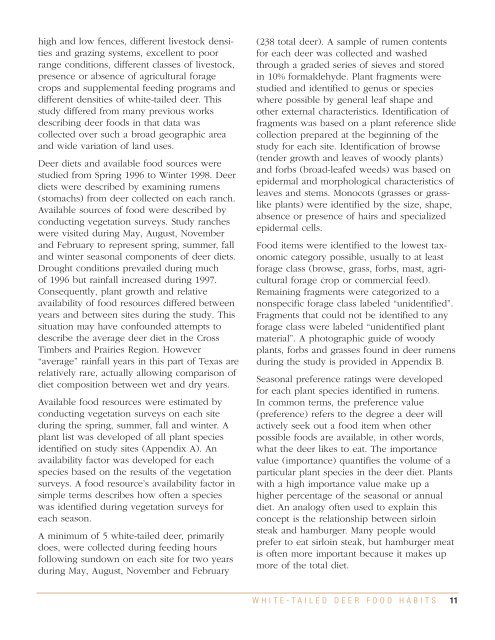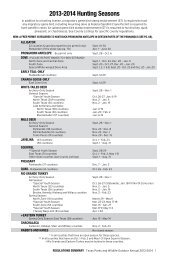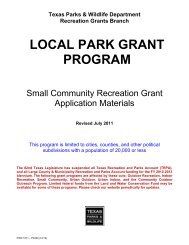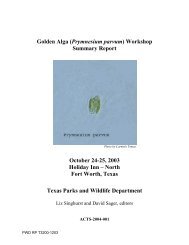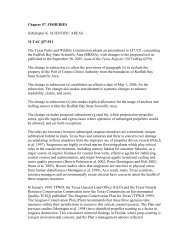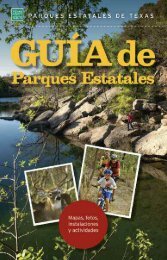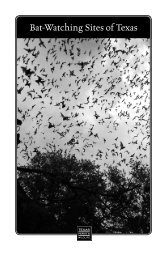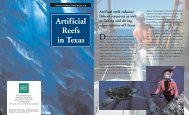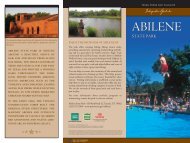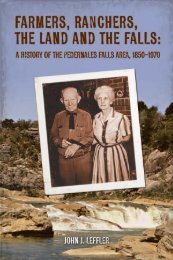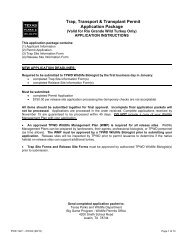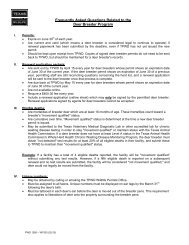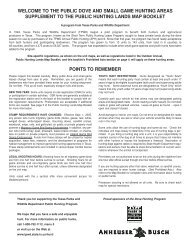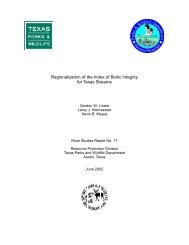White-tailed Deer Food Habits and Preferences in the Cross Timbers
White-tailed Deer Food Habits and Preferences in the Cross Timbers
White-tailed Deer Food Habits and Preferences in the Cross Timbers
You also want an ePaper? Increase the reach of your titles
YUMPU automatically turns print PDFs into web optimized ePapers that Google loves.
high <strong>and</strong> low fences, different livestock densities<br />
<strong>and</strong> graz<strong>in</strong>g systems, excellent to poor<br />
range conditions, different classes of livestock,<br />
presence or absence of agricultural forage<br />
crops <strong>and</strong> supplemental feed<strong>in</strong>g programs <strong>and</strong><br />
different densities of white-<strong>tailed</strong> deer. This<br />
study differed from many previous works<br />
describ<strong>in</strong>g deer foods <strong>in</strong> that data was<br />
collected over such a broad geographic area<br />
<strong>and</strong> wide variation of l<strong>and</strong> uses.<br />
<strong>Deer</strong> diets <strong>and</strong> available food sources were<br />
studied from Spr<strong>in</strong>g 1996 to W<strong>in</strong>ter 1998. <strong>Deer</strong><br />
diets were described by exam<strong>in</strong><strong>in</strong>g rumens<br />
(stomachs) from deer collected on each ranch.<br />
Available sources of food were described by<br />
conduct<strong>in</strong>g vegetation surveys. Study ranches<br />
were visited dur<strong>in</strong>g May, August, November<br />
<strong>and</strong> February to represent spr<strong>in</strong>g, summer, fall<br />
<strong>and</strong> w<strong>in</strong>ter seasonal components of deer diets.<br />
Drought conditions prevailed dur<strong>in</strong>g much<br />
of 1996 but ra<strong>in</strong>fall <strong>in</strong>creased dur<strong>in</strong>g 1997.<br />
Consequently, plant growth <strong>and</strong> relative<br />
availability of food resources differed between<br />
years <strong>and</strong> between sites dur<strong>in</strong>g <strong>the</strong> study. This<br />
situation may have confounded attempts to<br />
describe <strong>the</strong> average deer diet <strong>in</strong> <strong>the</strong> <strong>Cross</strong><br />
<strong>Timbers</strong> <strong>and</strong> Prairies Region. However<br />
“average” ra<strong>in</strong>fall years <strong>in</strong> this part of Texas are<br />
relatively rare, actually allow<strong>in</strong>g comparison of<br />
diet composition between wet <strong>and</strong> dry years.<br />
Available food resources were estimated by<br />
conduct<strong>in</strong>g vegetation surveys on each site<br />
dur<strong>in</strong>g <strong>the</strong> spr<strong>in</strong>g, summer, fall <strong>and</strong> w<strong>in</strong>ter. A<br />
plant list was developed of all plant species<br />
identified on study sites (Appendix A). An<br />
availability factor was developed for each<br />
species based on <strong>the</strong> results of <strong>the</strong> vegetation<br />
surveys. A food resource’s availability factor <strong>in</strong><br />
simple terms describes how often a species<br />
was identified dur<strong>in</strong>g vegetation surveys for<br />
each season.<br />
A m<strong>in</strong>imum of 5 white-<strong>tailed</strong> deer, primarily<br />
does, were collected dur<strong>in</strong>g feed<strong>in</strong>g hours<br />
follow<strong>in</strong>g sundown on each site for two years<br />
dur<strong>in</strong>g May, August, November <strong>and</strong> February<br />
(238 total deer). A sample of rumen contents<br />
for each deer was collected <strong>and</strong> washed<br />
through a graded series of sieves <strong>and</strong> stored<br />
<strong>in</strong> 10% formaldehyde. Plant fragments were<br />
studied <strong>and</strong> identified to genus or species<br />
where possible by general leaf shape <strong>and</strong><br />
o<strong>the</strong>r external characteristics. Identification of<br />
fragments was based on a plant reference slide<br />
collection prepared at <strong>the</strong> beg<strong>in</strong>n<strong>in</strong>g of <strong>the</strong><br />
study for each site. Identification of browse<br />
(tender growth <strong>and</strong> leaves of woody plants)<br />
<strong>and</strong> forbs (broad-leafed weeds) was based on<br />
epidermal <strong>and</strong> morphological characteristics of<br />
leaves <strong>and</strong> stems. Monocots (grasses or grasslike<br />
plants) were identified by <strong>the</strong> size, shape,<br />
absence or presence of hairs <strong>and</strong> specialized<br />
epidermal cells.<br />
<strong>Food</strong> items were identified to <strong>the</strong> lowest taxonomic<br />
category possible, usually to at least<br />
forage class (browse, grass, forbs, mast, agricultural<br />
forage crop or commercial feed).<br />
Rema<strong>in</strong><strong>in</strong>g fragments were categorized to a<br />
nonspecific forage class labeled “unidentified”.<br />
Fragments that could not be identified to any<br />
forage class were labeled “unidentified plant<br />
material”. A photographic guide of woody<br />
plants, forbs <strong>and</strong> grasses found <strong>in</strong> deer rumens<br />
dur<strong>in</strong>g <strong>the</strong> study is provided <strong>in</strong> Appendix B.<br />
Seasonal preference rat<strong>in</strong>gs were developed<br />
for each plant species identified <strong>in</strong> rumens.<br />
In common terms, <strong>the</strong> preference value<br />
(preference) refers to <strong>the</strong> degree a deer will<br />
actively seek out a food item when o<strong>the</strong>r<br />
possible foods are available, <strong>in</strong> o<strong>the</strong>r words,<br />
what <strong>the</strong> deer likes to eat. The importance<br />
value (importance) quantifies <strong>the</strong> volume of a<br />
particular plant species <strong>in</strong> <strong>the</strong> deer diet. Plants<br />
with a high importance value make up a<br />
higher percentage of <strong>the</strong> seasonal or annual<br />
diet. An analogy often used to expla<strong>in</strong> this<br />
concept is <strong>the</strong> relationship between sirlo<strong>in</strong><br />
steak <strong>and</strong> hamburger. Many people would<br />
prefer to eat sirlo<strong>in</strong> steak, but hamburger meat<br />
is often more important because it makes up<br />
more of <strong>the</strong> total diet.<br />
WHITE-TAILED DEER FOOD HABITS<br />
11


